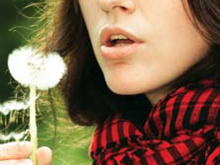Health Topics
-
Healthy Living
-
|
|
June 2010
|
| 10 Ways to Prevent & Treat Pollen Allergy |
| Dr Jyothsna Krishnappa |
| |
 |
Allergy is an overreaction (hypersensitivity) of the body to things (allergens) which would normally not cause any problem to other individuals. This causes manifestations in the respiratory system and the skin, collectively known as nasobronchial allergy. |
Pollination Fundas
A hypersensitive reaction to pollen is common during this holiday season.
- Pollen is comprised of small particles produced by plants during their process of reproduction. These particles are transported by wind to distant places to enable cross pollination and further propagation of these plants.
- Generally, the more plain looking plants produce more pollen and elicit a stronger allergic response than plants with very colourful flowers. We’ve always been told that looks are not everything, right?
- Pollen from trees, grass, weeds and also spores from moulds are widespread and seasonal in nature. Soil and organic waste may promote moulds to propagate spores according to climatic conditions. The levels of grass and flower pollen vary considerably according to atmospheric conditions.
- The pollinating season is usually in March to May for trees, in May to July for various kinds of grass and peaks in August to October for weeds.
- Pollen counts generally increase in the early morning and on windy, dry days.
- Pollen concentrations decrease in coastal climates, compared to plains and grasslands.
The Danger
- These air borne pollen cause seasonal allergic rhinitis, also known as hay fever or pollenosis. Over a period of time, depending on the individual and the extent of chronic exposure to the allergen, the condition may progress to become perennial allergic rhinitis.
- Most patients with allergic rhinitis have a family history of similar nasal symptoms or related symptoms including eczema or asthma.
- About 40 percent of those affected by allergic rhinitis may have asthma at some point of time. About 70 percent of asthmatics have associated allergic rhinitis.
- Allergic rhinitis is more prevalent under the age of 40 and symptoms are usually seen to diminish with increasing age.
The Mechanism
- Exposure to these aero-allergens triggers an immediate hypersensitivity of the inner lining of the nose, leading to excessive production of an antibody.
- The inner lining thus gets congested and inflamed with increased secretions, leading to the feeling of nasal blockage, sneezing and running nose.
- This inflammation could cause to frequent infections, leading to acute or chronic rhino-sinusitis.
10 Ways to Prevent & Treat
- Prevention of exposure to the offending agent is the most effective way to control symptoms. Affected individuals are advised to keep indoors during the pollen season, not to travel outside on dry, windy days and to keep windows shut especially when pollen counts are high.
- Showering or bathing before retiring at night helps reduce exposure to pollen present on the skin or hair.
- Use of air filters to minimise concentrations of air borne pollen is also recommended.
- Steam inhalation and avoidance of exposure to cold environments or fumes go a long way in improving symptoms.
- Simple measures like deep breathing exercises, pranayama and sudarshankriya techniques are helpful.
- Immunotherapy (desensitisation to the offending allergen by exposure micro amounts of it) is helpful, but is a long drawn out and expensive procedure. Allergy testing (invoking an allergic response by injection of tiny amounts of concentrated allergens) may be suggested if immunotherapy is contemplated.
- An ENT evaluation is recommended in view of possible presence of correctable obstructions like nasal polyps (an abnormal tissue inside the nose), deviated nasal septum and for treatment of chronic sinus infections.
- Medication like the antihistaminics may be used for two to four weeks.
- Nasal drops (containing oxymetazoline) are used for very short periods.
- Medication involving montelukast, antihistaminics and intranasal steroid sprays are highly effective in those with moderate to severe symptoms and may be used for longer periods.
|
7 Pollen Allergy Symptoms
- Recurrent sneezing
- Running nose
- Nasal obstruction
- Itching sensation in the nose, throat and eyes
- Watering and redness of the eyes
- Recurrent/ chronic cough
- Wheezing, when it involves the lower respiratory tract
|
 |
Dr.Jyothsna Krishnappa is Consultant Physician at Apollo Hospitals, Bangalore |
|
|
|